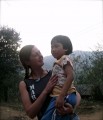Guidebooks and travel agencies advertise similar things in their hill trek tours: staying in a far removed hill tribe, cooking and eating native cuisine, elephant rides, visiting tea plantations, and so on. In my experience we got all that we paid for in our trek, but the isolated hill tribe we stayed in did not seem as disconnected from world progression as I had anticipated.
We began early morning by long-tail boat upriver in Chiang Rai province, just outside of the small city center. It was raining and the noisy but quick engine had us drenched in no time. We were brought to an elephant park outside of a small river village, the “park†merely a place where tourists hop on elephant back. We were carried along narrow streets inhabited by modest Thais in their daily activities. The roads were dirt rather than paved, lined with stray dogs and cats, scarf vendors, and numerous food carts.
After feeding our ride its share of bananas and bamboo we were whisked to a local wedding by our guide. Here we viewed a young veiled maiden and were asked to give a donation as a wedding gift. Next was our authentic Thai lunch, served around a ground table at our guide’s home in the village. It consisted of meat curries and stews, rice, pad thai, and native fruits; all to energize us for the hike to come.
Our trek package included an overnight stay in a remote hill village. As many westerners likely do, I pictured native people wearing little clothing, living without electricity, and any connections with the outside world. This was not the case, which we quickly discovered as some villagers traveling via motorbike passed us walking.
We were welcomed by the “tribe†with tea, handshakes, and the cutest puppy I’ve ever laid eyes on. None of the villagers spoke English, but they did all they could with facial expressions and gestures to make us feel comfortable. While the village was very friendly and the children were stoked to play with a sophisticated camera, it seems that the village has been transforming into a remote tourism lodge, with rooms, alcohol, and souvenirs for all who pass through.
Not only did making money seem top priority by villagers, but we were also shown dirt floor homes centered around the television. Village children wore Pokémon shirts and clung to pooh bears, playing a game similar to hacky sack. While of course some native, primitive customs still remain, others seem to have been overtaken by globalization. It is questionable whether the metamorphosis is largely due to an influx of tourism in the northern hills, the motorbikes that join them with town, or the television that connects them to the rest of the world. I suppose it is a mixture of many contributors.
I would guess that many tourists are surprised by their hill trek experience and begin to wonder, if even this remote hill tribe is being severely affected by globalization, is there any pristine place, any untouched peoples, who are truly evolving on their own? Or at this point, is nearly every person on the planet connected, both rich and poor, by some form of technology or another.
The only way to find out is by experience, and trekking for oneself.
Tips for Trekking in Northern Thailand:
Tip #1:
Chiang Rai is a superb place to book a hill trek, any length from one day to an entire week. The city is located a bit farther north of touristy Chiang Mai where trekking is a bit more costly. The larger the group the less you pay, but expect paying about 1200 Thai baht, or $40 US, per day. This price includes all meals, sleeping accommodations, activities, and a guide (everything but alcohol and opium which the village will likely try to sell to you!).
Tip #2:
Don’t feel like you must book your trek in advance, as you will likely get hit with a higher Internet price. Most guesthouses will book a tour for you, and many have their own guides for hire. Chat Guesthouse in Chiang Rai was busy with an alternative crowd, great meals, and helpful staff. They even have a trek booking area where you will be shown trekking pictures and a map of the region. You can book on the spot and leave the next day.
 Tip #3:
Some of my fellow trekkers felt the hike was very strenuous, so make sure you have proper shoes, a light backpack, water, and pants, as many of the trails aren’t perfectly maintained. You will cross a multitude of villagers selling souvenirs, food, and beverages, so some extra cash would be helpful. Guides and helpers also expect tips.

